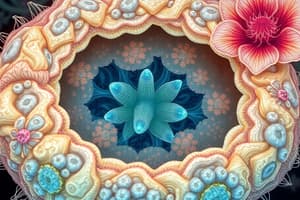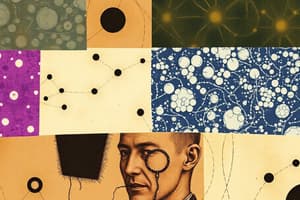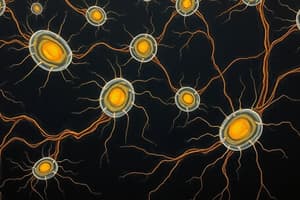Podcast
Questions and Answers
Which part of a plant cell is responsible for photosynthesis?
Which part of a plant cell is responsible for photosynthesis?
- Vacuole
- Chloroplasts (correct)
- Cell wall
- Nucleus
What is the primary function of red blood cells?
What is the primary function of red blood cells?
- Transport oxygen (correct)
- Transport nutrients
- Provide immunity
- Fight infection
Which of the following correctly describes a feature of a nerve cell?
Which of the following correctly describes a feature of a nerve cell?
- Contains chloroplasts
- Disc-shaped
- Long and thin with connections at each end (correct)
- No nucleus
Which organism can be categorized as unicellular?
Which organism can be categorized as unicellular?
What is the role of the vacuole in a plant cell?
What is the role of the vacuole in a plant cell?
How do glucose and oxygen enter cells?
How do glucose and oxygen enter cells?
What is a unique characteristic of sperm cells?
What is a unique characteristic of sperm cells?
Which component is common to both plant and animal cells?
Which component is common to both plant and animal cells?
What movement process allows carbon dioxide to leave cells?
What movement process allows carbon dioxide to leave cells?
Which of these is a method used to enhance visibility when using a microscope?
Which of these is a method used to enhance visibility when using a microscope?
Flashcards are hidden until you start studying
Study Notes
amoeba A unicellular organism.
cell wall The plant cell component that surrounds the cell, providing
support.
cells The smallest functional units in an organism – the building
blocks of life.
chloroplasts The plant cell component where photosynthesis takes place.
concentration A measure of the number of particles of a substance in a given
volume.
diffusion The movement of liquid or gas particles from a place of high
concentration to a place of low concentration.
euglena Unicellular organism that performs photosynthesis.
flagellum A tail-like structure that allows euglenas to move.
leaf cell The plant cells that contain chloroplasts, where photosynthesis
takes place.
microscope An optical instrument used to magnify objects, so small details
can be seen clearly.
nerve cell An animal cell that transmits electrical impulses around the
body.
nucleus The cell component that controls the cell and contains genetic
material.
observation Carefully looking at an object or process.
organisms Living things.
red blood cell An animal cell that transports oxygen around the body.
root hair cell A plant cell that takes in water and minerals from the soil.
specialised cell A cell whose shape and structure enable it to perform a
particular function.
sperm cell A cell containing male genetic material.
unicellular Consisting of just one cell.
vacuole The plant cell component that contains cell sap and helps to
keep the cell firm.
Studying That Suits You
Use AI to generate personalized quizzes and flashcards to suit your learning preferences.





